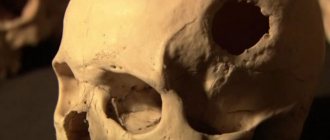Home»Articles»Psychological problems after the loss of a loved one
Published: April 15, 2020 at 11:37 am
Every day on the planet people die for one reason or another. This sad event leaves close family and friends in a state of loss that can last for years. Denial, aggression, guilt, depression that appear after the death of a loved one are reactions considered absolutely normal when experiencing the trauma of loss.
Psychologists believe that on average an individual goes through all stages of grief due to the death of a loved one within a year. A person can experience the sudden and premature death of his own child especially acutely. There are often cases when the lack of proper sleep, a hysterical state, and a feeling of devastation lead to serious mental disorders, including clinical depression.
How to cope with the loss of a loved one
So. A woman, 55 years old, a working pensioner, contacted us. Her initial request was for daily, chronic headaches.
Externally - neat, hairstyle, good clothes.
At first glance, she was energetic and cheerful, but behind this apparent energy one could discern some kind of fussiness and haste.
She said that she had been having headaches for 14 years. Daily.
During this time I tried all types of treatment, the pills did not help, they relieved the pain for a short time and it came back again.
At the very first consultation, we went from the symptom of headache to a situation of grief (loss of our son). The connection became obvious to both of us.
A more careful and detailed assessment of her psychological state revealed a deeply traumatized state. Her condition was as if it were yesterday.
Fussiness helped to constantly be in the whirlwind of everyday affairs and work, and was a good way to “escape” from severe mental pain. She couldn't even walk evenly and slowly. So as not to constantly wonder how to live after the loss of loved ones.
Her fussiness and constant haste acted as a way to protect her psyche from deep internal pain. Thus, the mind was always busy with things and there was no time to think about anything else.
It was dangerous to be left alone with your thoughts; memories could immediately come flooding back and “cover your head.”
The brain acts independently
All of these reactions have one thing in common: the bereaved person feels, in a certain sense, helpless. He practically cannot consciously control his reactions. The brain essentially acts on its own. The fact is that the shock caused by the death of a loved one throws another area of the brain out of balance. In addition to the brain stem, cerebellum and limbic system, experiences affect the neocortex, which is responsible for our thoughts and actions.
With the shock caused by the death of a loved one, the functioning of the neocortex is also disrupted. Because of this, the person cannot think and act as usual. It becomes more difficult for him to control feelings and impulses. Therefore, he is practically helpless against shock reactions. For example, a person does not want to react to something aggressively, but he cannot restrain himself. Or a person wants to take life into his own hands again, but cannot overcome his internal numbness.
On top of that, thoughts often go in circles. So, for example, a person constantly thinks about what to do. How to live further? Sell a house? Move? Or stay in your familiar surroundings? How will normal days go? How to celebrate Christmas? Or birthdays? How to spend your vacation? Thoughts keep coming back to the same thing. It's very difficult to make decisions because everything has changed.
Thoughts may also revolve around the past. A person constantly goes through memories in his mind, he may be tormented by a feeling of guilt, he constantly regrets that he did something wrong or torments himself with the question: “Why did this happen to me? Why was my child, my companion, my friend gone?”
How to cope with grief
Grief includes a wide range of feelings - it is not just one feeling.
There is abandonment (a feeling of loneliness, isolation), anger, anxiety, panic, depression (depression), fear, annoyance, regret, frustration, guilt, shame, envy (of those who are doing well), love.
We all need to understand that grief is a long process, extended over time, and psychological techniques will not help here.
Competent, long-term support helps here.
We would like to note that everyone experiencing grief goes through four stages :
1. emotional shock, numbness; 2. longing and desire to return the lost person; 3. disruption of organization, order and despair (this is the stage of depression); 4. resolution (way out of the situation).
After fourteen years of mental anguish, she was still in the second and third stages at the same time.
Her consciousness, under the pressure of the news of what had happened, instantly split (a state of shock) and this caused memory lapses. The series of events was remembered in fits and starts, it was not complete, it was broken.
At the moment of shock, psychological defenses were triggered, hence the numbness. She felt nothing, her senses were turned off.
Since everything happened in the hospital, the doctors gave her injections so that she would simply “pass out” and sleep. It was the best that could be done at that moment, but then, as you understand, it didn’t get any easier.
It must be said that those around her at such a moment could not help her in any way, there were no skills, no knowledge.
What are the consequences of the first shock?
Reactions to death occur in our brain. The death of a loved one is like a severe shock that disrupts normal processes. Certain areas of the brain are particularly affected:
1. brain stem and cerebellum, responsible for basic activities such as eating, sleeping, breathing, blood circulation, etc.;
2. the limbic system, which controls emotions and conscious memory, as well as a sense of time and orientation in space.
When a severe shock, such as death, throws these areas of the brain out of balance, what most often happens is:
sleep is disrupted, appetite disappears, and health worsens. A person forgets ordinary things, is poorly oriented in space and can get lost even on the most familiar routes.
In addition, the shock caused by death has the same effect as a threat. The response of the brainstem, cerebellum and limbic system to threat has not changed since ancient times. This
- flight, - aggression or - numbness.
These reactions can occur alternately.
Grief and psychosomatics
All the advice that the client received from others boiled down to banal words: you shouldn’t grieve so much, you should be strong, brace yourself. And she tried to restrain herself as best she could.
Of course, it is difficult for others to withstand the prolonged emotional stress of a grieving person and therefore they want to leave quickly, since looking at all this is unbearable.
Therefore, she was left “alone” with her situation. Not knowing how to cope with the loss of a loved one.
As a result, all these tips led to even greater blocking of feelings. It would be better to respond to them in time.
It was against the backdrop of strong, unreacted feelings that the disease arose. The intense intensity of feelings was repressed into the unconscious part of the memory and from there provoked a daily headache.
At that time, she found a way out in complete immersion in work.
She plunged into work from 8.00 to 22.00, with one day off per month. She went to work early and arrived late. I fell asleep and had no time to think, to remember my pain.
Then the fussiness and constant rush arose.
Tears and crying for the deceased
The funeral ritual also has some mysterious mythical meaning. Tears and crying in the traditions of many peoples symbolize not only the natural expression of pain, grief, suffering, but also carry a form of ritual behavior. Previously, specially hired mourners were invited to the funeral; mourning the deceased, they ask him for forgiveness on behalf of all those present. An unmourned dead person will not be forgiven, which means he will suffer in the next world.
In “The Tale of Peter and Fevronia of Murom,” Fevronia, when asked by Peter, where are your parents, replies: “...my father and my mother went on loan to cry - they went to the funeral and mourned the deceased there. And when death comes for them, others will mourn them: this is crying on loan.” Cry
was also a way of communicating with deceased ancestors and asking them to accept a new member into the afterlife. Another funeral lament is a kind of appeal to the deceased with a request to convey greetings to relatives in the next world.
Tears before the coffin
- this is the same as in a wedding ceremony, a sign of gratitude to the deceased for being close to loved ones for many years. Nowadays, people turn to God less often, only in the most difficult moments of life and at the time of the death of their neighbor. If God is nevertheless remembered, God's plan regarding death should be deeply understood. No wonder they say: “God gave, God took.” From the Orthodox point of view, death is falling asleep, “dormition”, hence the term “deceased”, that is, death is a transition to another, eternal life. The human body is the “temple of God”: “Don’t you know that you are the temple of God, and the Spirit of God lives in you?” (1 Cor. 3:16). Caring for the body of the deceased is associated with the main Christian postulate of the Resurrection. The cemetery is also called a “graveyard,” meaning that the dead came here only to stay. Funeral lamentation is understood as helping the deceased to atone for all sins on earth and go to the Eternal Kingdom to be resurrected.
It's not scary to die, it's scary to disappear without a trace
How to cope with the loss of a loved one with the help of a psychologist
At our meetings we worked with her experiences, feelings and sensations, with everything that happened.
Even though so much time had passed, she could not be “touched” at all. You touch it, and tears flow, your consciousness “goes away,” your eyes become clouded, your mind doesn’t understand anything—you immediately fall into retraumatization.
Helping a person and not injuring him again is not an easy task. The strongest feeling, dominating over the rest of the conglomerate of feelings, was anger and guilt.
In her case, anger “worked” in both directions, on the perpetrators, those responsible for what happened and on herself, because she could not prevent the event.
Guilt, because she could not save, although this was in no way in her ability.
Her future closed at that moment and life no longer mattered.
As we said above, grief is a process. The most difficult thing is to navigate through all the feelings and bring them to the fourth stage, “Resolution.”
To a stage where she can accept the fact of loss, accept the situation and learn to live on, find meaning in later life.
Funeral rite
Recently I myself witnessed a funeral service for a deceased person in a church. I was struck by the words of Priest Peter: “For forty days the soul wanders the earth, answering to God, turning to the souls of loved ones with a request for forgiveness, your task is to help the soul find peace, forgive and accept its concept of eternal life.”
But many people do not know how to prepare a deceased person for the transition to another life. Realizing that the soul is immortal, and at the second coming of Christ the bodies of the dead will be resurrected, uniting with souls, the body is carefully prepared for burial: washed, dressed in new clean clothes and covered with a white shroud. Before placing the body in the coffin, it is sprinkled with holy water. A pillow stuffed with sawdust or straw is placed under the head of the deceased; the hands should be folded crosswise, the right hand on top, the left hand on the bottom, hands and feet should be tied (untied just before burial). A pectoral cross must be placed on the neck of the deceased, a funeral cross is given in the hands, and an icon is placed on the chest - the image of the Savior (for a man) or the image of the Mother of God (for a woman). A crown is placed on the forehead of the deceased - a symbol of the crown, faith and accomplishment of life’s feat. The concept of “incorruptible crown” is a symbol of hope for the Resurrection.
If the coffin is at home, it is located in the middle of the room with the head towards the icons and feet towards the door. There is a misconception that it is necessary to cover mirrors in the house for forty days after death so that the soul does not see itself in them. According to Priest Peter, these are inventions that do not correspond to the traditions of the church. There is no need to cover mirrors and TV screens. Just like it is unnecessary to keep a glass of vodka or water in the house with a piece of bread on top, since the soul of the deceased no longer needs physical food.
How long did it take to cope with the loss and what was the result?
The work was carried out for a year and a half, three times a week, and we completed it. 1.5 years of therapy versus 14 years of lost life. The question “How to cope with the loss of a loved one” has been resolved for her.
The headache is gone. There is still sadness, but a light sadness. What remains is love without pain.
She began to walk with pleasure, slowly, without rushing anywhere. And she turned back to her own life.
Of course, a specialist will help you work through this situation more deeply and quickly. After all, that's what he works for. We wrote about how to choose your specialist here.
Ask your questions in the comments. Always happy to help!
Funeral service and burial
Burial
will take place on the third day after death.
If a person has been baptized, then the funeral service will be performed by a clergyman. The funeral service
helps the deceased to free himself from sins that he did not have time to confess. If a person was an atheist, a suicide or an unbeliever, there is no point in holding a funeral service. During the funeral service, everyone present must pray. The soul leaves the body on the third day and begins to suffer from its own imperfections, so loved ones must pray diligently to help it pass the final tests. Only artificial flowers are placed in the coffin of the deceased; real flowers will wither in the same way as the body of the deceased withers. No things of the material world are placed in the coffin of the deceased, since in the next world the soul will no longer need them.
Prayer at the funeral service
has magical powers, those present need to listen and comprehend the words of the chants. Participation in the funeral service for the deceased will allow those saying goodbye to stop for a moment, turn inside themselves and think about their existence on earth, what awaits us beyond the line of death and whether earthly life is sinless. During the funeral service, close relatives hold lit church candles in their hands, which will then need to be lit again on the grave before burial, and subsequently thrown into the grave along with the earth, leaving only three for the wake on the day of death, nine and forty days. At the end of the ceremony, the priest gives the relatives burial soil, which will need to be sprinkled crosswise on the body of the deceased before lowering it into the grave. The burial ground testifies to the fact that we were created from the ground and will return to the ground.
After the funeral service, the coffin of the deceased is closed with a lid, which is opened for the last time before burial. According to church rules, the coffin is carried out feet first and carried by close relatives or friends. At the cemetery, the last farewell to the deceased takes place, relatives and friends kiss him on the forehead, thereby asking for forgiveness. After untying the arms and legs, the body is sprinkled crosswise with burial soil, the lid of the coffin is nailed down (after this it is no longer possible to open the lid), and it is lowered into the ground. After which, first the relatives, and then everyone present, throw a handful of earth on the coffin.
This ritual has pedagogical significance, symbolizing the frailty of existence and reminding the living of their awaiting fate. After the coffin is buried, a tombstone cross
so that the face of the deceased is turned towards him. You cannot invite a brass band to the funeral of an Orthodox Christian, and you cannot bury him on the day of Holy Easter and on the day of the Nativity of Christ. The clothing of those present should be strict, dark if possible; it performs an educational, spiritual, and protection from sins function. Formal clothing presupposes organized, strict behavior, which is necessary for prayer.
Immediately after the death of a loved one (before the funeral service and burial), relatives should order Sorokoust from the church - a memorial prayer that is read for forty days and serves as a cleanser for the soul of the deceased. It is customary to organize a wake on the day of the funeral, on the ninth and fortieth day after death. It should be remembered that a wake is, first of all, a commemoration, that is, a prayer. Alcoholic drinks are inappropriate at the funeral table; according to Orthodox tradition, kutia, a sweet rice dish, must be on the table. Cereals are a symbol of rebirth, and sweet raisins are sweetness and joy in eternal life. A prayer must be read over the kutya; the rest of the meal takes place in a free form.
Today, when interest in folk spiritual traditions is being revived, it is important to get acquainted with the ritual culture from the inside, based on the foundations of the Orthodox Church. But most importantly, in order to help the soul of the deceased, we ourselves must come to God: keep the commandments, admit our sins, do good deeds. It is also important to preserve the good memory of the deceased person and pass it on to subsequent generations by talking about the deeds of the ancestor, visiting and caring for his grave. According to Orthodox beliefs, the departed souls of even our most distant ancestors help us from the other world and guide us through life, illuminating the path.
Author Yulia Savelyeva
Coffin and wreath
Even if you decide to cremate the body, you will still have to buy a coffin - this is required by sanitary standards.
The criteria by which you need to choose a coffin are its appearance and affordability. Coffins that are upholstered with fabric are the cheapest - from 2.5 thousand rubles. Wooden and polished coffins are more expensive - pine from 12 thousand rubles and maple or beech from 25 thousand rubles and more.
You can also buy an elite coffin made from solid cherry or oak. The inside of such a coffin is lined with velvet or crepe. Cost from 100 thousand rubles and above.
A wreath is your final gift to the deceased. It can be made of fresh flowers or artificial ones, with a signed ribbon on which the text you need will be written. You can buy a ready-made wreath, or you can order one to suit your taste - for example, from flowers that a person dear to you loved during his lifetime. A ready-made wreath can be purchased at a funeral service bureau, a specialty store, or at a cemetery.
Understanding: The brain helps itself by producing dopamine and serotonin
Knowledge of the processes occurring in our body during stressful situations helps us understand ourselves in moments of grief. The person still feels helpless and cannot control his feelings, but he blames himself less for his reaction to what is happening. Thanks to this information, friends and acquaintances also better understand what is happening to people experiencing grief and can give them more support.
With an understanding attitude towards oneself, the brain increases the production of the mediator substances dopamine and serotonin. Thanks to them, your well-being improves and you have more energy. The brain releases more serotonin and dopamine if a person has a positive attitude towards himself and does not judge himself for his behavior. This can also be facilitated by understanding and acceptance from other people. If others are sympathetic to unusual behavior, such as a person withdrawing into himself for a while, becoming irritable and not interested in a “normal” life, he feels that others accept him and his sadness. This sensation can also increase the release of serotonin and dopamine.
If you are grieving the death of a loved one, try to treat yourself with understanding and love. For many, this turns out to be a difficult task. People grieving the loss of loved ones often judge themselves for their despair, pain, or other feelings. They think they could control themselves.
How can you treat yourself more kindly? Especially if you previously treated yourself without much understanding?
It is very important to accept everything as it is. Now I am not talking about the death of another person, but about my own thoughts, feelings and behavior.
For example, you might regularly ask yourself:
- How do I feel now? - What am I thinking now? - What do I want to do now?
The answers to these questions should be left as they are, without attaching any “Yes, but...” to them. You need to allow yourself all the feelings and thoughts. At least for a little while. Feel pain, despair or hope that your loved one is better now.
And wishes are worth fulfilling. Go to some beautiful place, listen to music, maybe look at photos of your loved one. Or do something completely different. Exactly what you want. Even if you want something unusual.
What to do next?
After you receive the death certificate, you will need to collect the documents necessary for the funeral. First you need to obtain a stamp death certificate from the regional registry office. To obtain a certificate, you will need to present a medical death certificate, your passport and the passport of the deceased. When receiving the certificate, check the correct spelling of the date and place of birth of your relative, the date and place of death, the presence of a round seal and all the necessary signatures. This is very important, because then nothing can be corrected in the stamp certificate.
The registry office will also issue you a death certificate, form 33. Using this certificate, you will receive a social benefit for the funeral. This benefit is paid to the person who organized and paid for the funeral. Funeral benefits are received at the institution where the deceased worked or studied. If a pensioner has died, you need to contact the Russian Pension Fund.
Don’t forget to pay for the morgue’s services and give its workers the necessary things for the deceased. For a man you will need:
- underwear;
- socks;
- suit, shirt, tie;
- shoes;
- handkerchief;
- soap, towel;
- comb;
- disposable razor;
- alcohol-containing lotion;
- dentures.
For woman:
- underwear;
- slip or nightgown;
- stockings or tights;
- headscarf;
- shoes;
- alcohol-containing lotion;
- soap, towel;
- comb;
- dentures.
To avoid forgetting anything, write yourself a complete list of the essential components of a funeral. The most important thing you should prepare:
- stamp death certificate;
- a body in a suit and makeup;
- crematorium (if the body will be cremated);
- a place in a cemetery or columbarium;
- coffin (for cremation - urn) and wreaths;
- transportation of the body;
- farewell procedure.
In addition, do not forget to notify relatives and friends and, if desired, order and pay for an orchestra or church ritual ceremony.
Returning from the funeral
Upon returning home, you need to touch the stove. This sign arose a long time ago and is due to the fact that the stove identifies the element of fire. Elder people say that by touching the stove, you can burn away all the bad omens. If there is no stove or something similar, you need to light a candle, it will also help burn away all the bad things.
Funeral procession
As customs say, if a funeral procession passes by your house, you cannot have anyone sleeping in the house. They say that a dead person can drag a sleeping person with him. You can’t look out the window at the procession; it’s better to close the curtains and be in silence. You cannot cross the path of a funeral procession. It is believed that if the deceased was sick, the person who crossed the road can take his illness for himself. The day of the funeral is very difficult and painful, but it must be done correctly, no matter what. It is important to follow all the rules, hold a memorial dinner and pay tribute to the deceased. Some people firmly believe in these signs, while others consider them superstition. You are free to decide for yourself.
Read: This is why Tibetan Mahatmas and all beautiful women drink hot water in the morning
(No ratings yet)
Similar materials: loved one, last, life, don’t do, you can’t, bad, seeing off, path, burial, person, this
If your loved one died at home
If he died at night, then you need to call an ambulance and the police. Doctors pronounce death, police officers examine the body for signs of violent death. Then the police issues a report with the results of the examination, and the ambulance issues a death certificate. Only with these two documents can the body be accepted into the morgue.
After the visit of the police and ambulance, call a special service for transporting the dead. They will take the body and the documents you received - a death certificate and a protocol for examining the body. When the day arrives, you will have to go to the address that the transportation workers give you and issue a death certificate. To complete it you will need:
- passport of the deceased;
- his outpatient card;
- health insurance policy;
- applicant's passport.
If your loved one died during the day, contact your local clinic. The doctor examines the body and pronounces death.
Difference between grief and complicated grief
The difference between grief and clinical complicated grief is not always easy to define, as they share many common symptoms. However, there is still a difference. Of course, grief can be very deep and bitter. It includes a wide range of emotions and a mix of good and hard days. But even when you reach only the middle of the grieving process, as you continue to grieve, you will already allow moments of joy. With depression, on the contrary, the feeling of emptiness and despair is constant.
Other features that indicate the presence of complicated grief:
- deep, all-consuming feeling of guilt;
- thoughts of suicide or preoccupation with death;
- feelings of hopelessness and worthlessness;
- lethargy, slow speech and body movements;
- loss of ability to perform daily tasks at home and at work;
- auditory or visual hallucinations.










